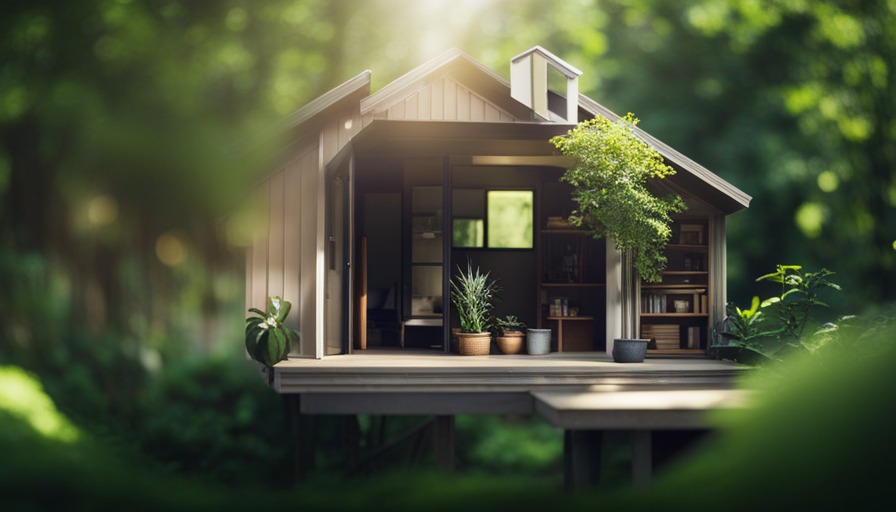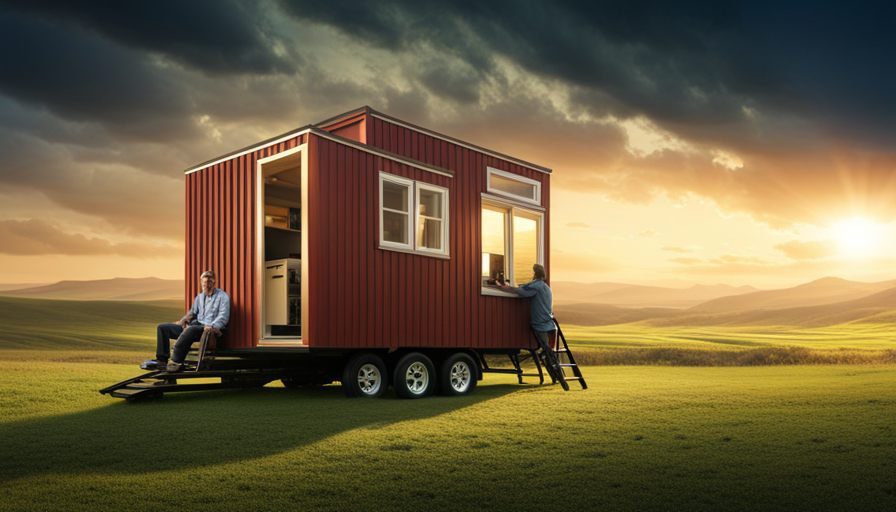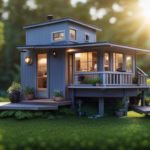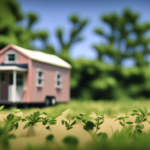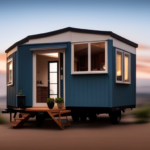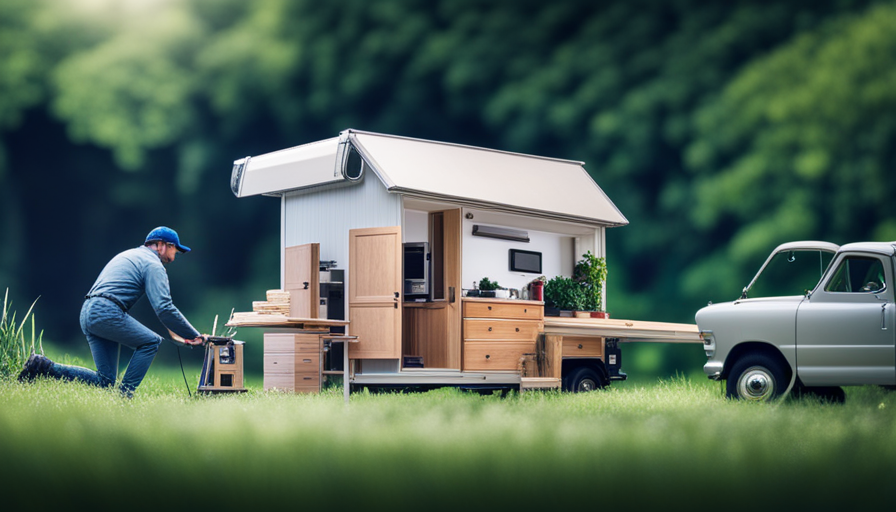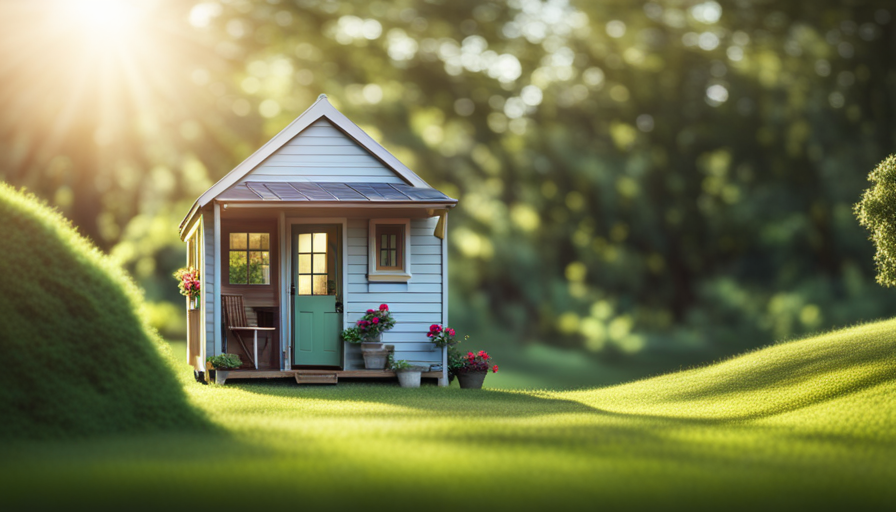I recall a story about someone who wanted to escape the traditional home arrangement. They desired a minimalist lifestyle where everything they owned had a purpose and every inch of space was cherished. They found their answer in a tiny house, a cozy retreat on wheels. But, as they began planning their dream home, they encountered a maze of laws and restrictions.
How big could their tiny house be without crossing the line into illegality? This question plagues many aspiring tiny house dwellers, and in this article, we will explore the answer. By diving into the world of tiny house regulations, embracing creative design solutions, maximizing vertical space, considering transportability, adhering to building codes and safety standards, consulting with professionals, and staying informed about changing regulations, we will uncover the secrets to crafting a tiny house that is both legal and livable.
So, join me as we navigate the intricate landscape of tiny house dimensions, and discover the boundless possibilities that lie within the constraints.
Key Takeaways
- Tiny house regulations and restrictions, such as minimum square footage requirements and zoning restrictions, determine the size and height of a tiny house.
- Creative design solutions, such as utilizing space-saving furniture and storage solutions, can help maximize the limited space in a tiny house.
- Transportability considerations, like weight and road clearance, should be taken into account when building a tiny house.
- It is important to comply with building codes and safety standards, obtain necessary permits and licenses, and consult professionals for guidance on regulations and cost-effective options to maintain a legal and stress-free living situation in a tiny house.
Understanding Tiny House Regulations
To better comprehend the regulations surrounding tiny houses, it’s imperative to understand the limitations on their size. One of the key factors in determining the legality of a tiny house is the minimum square footage required by local authorities.
While the exact measurements may vary depending on the jurisdiction, many areas have a minimum square footage requirement, usually ranging from 100 to 400 square feet. Additionally, zoning restrictions play a crucial role in determining the size of a tiny house.
Some areas have specific zoning codes that dictate the maximum size or height of a structure. It’s important to review these regulations carefully to ensure compliance. Understanding the minimum square footage and zoning restrictions will provide a solid foundation for exploring creative design solutions in the subsequent section.
Creative Design Solutions
With a dash of imagination, a tiny living space can stretch its boundaries like an elastic band, offering ingenious design solutions that will leave you marveling. One of the key elements to making the most of a tiny house is utilizing space-saving furniture and innovative storage solutions. By incorporating multi-functional pieces such as foldable tables, sofa beds, and wall-mounted shelves, you can maximize every inch of your limited living area. Additionally, clever storage options like hidden compartments, built-in cabinets, and under-bed storage can help keep your space clutter-free. To make the writing more interesting, here is a table showcasing some examples of space-saving furniture and storage solutions:
| Furniture/Storage Solution | Description |
|---|---|
| Murphy Bed | A bed that folds up into the wall during the day |
| Lofted Bed | A bed raised on a platform, creating space underneath |
| Ottoman with Storage | A footrest that opens up to reveal hidden storage |
By implementing these creative design ideas, you can truly make the most of your tiny house. Now, let’s explore how to maximize vertical space without compromising comfort.
Maximizing Vertical Space
Imagine how much more functional and spacious your living area could be by utilizing the vertical space in your tiny home. One of the key ways to maximize vertical space is by incorporating space-saving furniture. For example, a Murphy bed can be installed on a wall, folding up when not in use and freeing up valuable floor space.
Another option is to utilize lofted sleeping areas, which can be accessed by a ladder or stairs. This not only saves space but also creates a cozy and private sleeping space.
Additionally, consider installing shelving units or cabinets that extend from floor to ceiling, providing ample storage space while utilizing the vertical height of the room.
By taking advantage of these vertical space solutions, you can make your tiny home feel much more spacious and functional. When considering transportability, it’s important to keep in mind the weight and size limitations for easy relocation.
Considerations for Transportability
When it comes to making your small living space easily transportable, there are important factors you need to consider.
First, weight restrictions play a crucial role in determining the size of your tiny house. Keeping the weight within legal limits ensures that you can transport it without any issues.
Second, road clearance is another essential consideration. Low-hanging branches, power lines, or bridges can pose challenges during transportation. By maximizing the vertical space, you can avoid these obstacles and ensure a smooth journey. Additionally, having a collapsible roof or detachable features can further enhance transportability.
Addressing these factors will help you design a tiny house that is both functional and easy to move.
Ensuring compliance with building codes and safety standards is the next crucial step in creating your dream tiny home.
Building Codes and Safety Standards
One way to ensure your small living space is compliant with building codes and safety standards is by carefully considering weight restrictions and road clearance. When building a tiny house, it’s essential to obtain the necessary building permits to ensure that your structure meets all the legal requirements.
This includes adhering to fire safety regulations, such as installing smoke detectors and fire extinguishers. Additionally, it’s important to consider the weight of your tiny house to ensure that it doesn’t exceed the limits imposed by transportation regulations. This will ensure that your tiny house can be safely transported without causing any damage to the roads or bridges.
By taking these factors into account, you can ensure that your tiny house is both legal and safe. Consulting with professionals in the field can provide further guidance on how to navigate these regulations and ensure your tiny house meets all necessary requirements for both building codes and safety standards.
Consulting with Professionals
Hiring experts in the field can provide valuable insight and guidance on how to navigate regulations and ensure your compact dwelling meets all legal requirements and safety standards.
When consulting with professionals, you can discuss the financial implications of building a tiny house, as they can help you determine the cost and potential savings associated with various eco-friendly features. They can advise on the most efficient and cost-effective materials, appliances, and systems, helping you make informed decisions that align with your budget and sustainability goals.
Additionally, professionals can keep you updated on any changing regulations or building codes that may affect your tiny house project. Staying informed and adapting to these changes will ensure your dwelling remains legal and safe.
Staying Informed and Adapting to Changing Regulations
To stay in the loop and ensure you’re on the right side of the law, it’s crucial to keep yourself updated and adapt to any changes in regulations, ensuring that your compact dream home remains a legal and secure haven. Staying informed about legal implications and zoning restrictions is essential to avoid any legal issues and fines. Zoning restrictions vary from one area to another, so it’s important to consult with local authorities and professionals to understand the specific regulations in your location. By staying informed, you can make informed decisions about the size and design of your tiny house. It’s also important to adapt to changing regulations, as they may evolve over time. This can involve obtaining permits, adjusting the size or layout of your tiny house, or relocating if necessary. Adapting to changing regulations will help you maintain a legal and stress-free living situation in your tiny house.
| Legal Implications | Zoning Restrictions |
|---|---|
| – Understanding local laws and regulations | – Researching zoning requirements in your area |
| – Obtaining necessary permits and licenses | – Complying with size and setback regulations |
| – Adhering to safety and building codes | – Assessing restrictions on utilities and parking |
| – Addressing concerns about property values and neighborhood aesthetics | – Seeking variances or waivers if needed |
| – Avoiding fines and legal disputes | – Consulting with professionals for guidance |
Frequently Asked Questions
What are some common challenges faced by tiny house owners in terms of transportability?
Challenges faced by tiny house owners in terms of transportability include weight restrictions, road regulations, and finding suitable towing vehicles.
Tiny houses need to be built with lightweight materials to stay within weight limits, which can limit design options.
Road regulations vary by jurisdiction, with some roads and bridges having weight or width restrictions that may hinder transportation.
Additionally, finding a suitable towing vehicle with enough power and stability can be a challenge.
However, there are solutions like consulting with transportation experts and designing tiny houses to meet road regulations.
Are there any specific building codes or safety standards that apply to tiny houses?
Building codes and safety standards are crucial when it comes to tiny houses. Did you know that only 37% of US states have specific building codes for tiny houses?
This lack of uniformity can make it challenging for tiny house owners to ensure building code compliance and adhere to safety standards. However, it’s essential to prioritize safety by following guidelines for electrical, plumbing, and structural requirements.
Additionally, fire safety measures should also be implemented to ensure the well-being of occupants.
How can consulting with professionals help in navigating through tiny house regulations?
Consulting professionals can be invaluable when navigating through tiny house regulations and legal considerations. They possess the knowledge and expertise to guide individuals through the complex process. By seeking their advice, one can ensure compliance with building codes and safety standards, avoiding potential legal issues.
Professionals can provide detailed information on size restrictions and other regulations, helping individuals determine how big their tiny house can be without crossing legal boundaries. Their guidance can ultimately save time, money, and potential headaches.
What are some creative design solutions to maximize space in a tiny house?
As an aficionado of tiny living, I’ve discovered some ingenious ways to maximize space in a tiny house. Space-saving furniture is key to optimizing every square inch. Think multifunctional pieces, like a sofa that transforms into a bed or a dining table that folds away when not in use.
Innovative storage solutions are also essential. Utilize vertical space with built-in shelves and cabinets, and consider hidden storage compartments under stairs or in walls. These clever design choices can turn a tiny space into a functional and stylish home.
How can tiny house owners stay informed about changing regulations and adapt accordingly?
To stay informed about changing regulations and adapt accordingly, tiny house owners should actively research and follow local zoning laws and building codes. This can be done by regularly checking government websites, attending town hall meetings, and joining online forums or social media groups dedicated to tiny house living.
Additionally, it’s important to consult with professionals, such as architects or lawyers specializing in housing regulations, to ensure compliance. Finding legal loopholes may be possible, but it’s crucial to prioritize safety and adhere to the law.
Conclusion
In conclusion, navigating the legal boundaries of tiny house living can be like walking a tightrope, but with the right knowledge and guidance, you can reach for the stars.
By understanding regulations, exploring creative design solutions, and maximizing vertical space, you can push the limits of how big your tiny house can be.
Remember to consider transportability, adhere to building codes and safety standards, consult with professionals, and stay informed about changing regulations.
With these tools in your arsenal, your tiny house dreams can soar to new heights.
Hi, I’m Emma. I’m the Editor in Chief of Tiny House 43, a blog all about tiny houses. While tree houses are often associated with childhood, they can be the perfect adult retreat. They offer a cozy space to relax and unwind, surrounded by nature. And since they’re typically built on stilts or raised platforms, they offer stunning views that traditional homes simply can’t match. If you’re looking for a unique and romantic getaway, a tree house tiny house might just be the perfect option.
